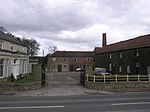Middleton Lodge

Middleton Lodge is a Georgian Palladian mansion set within 200 acres (0.81 km2) of open countryside, on the outskirts of the village of Middleton Tyas, a mile or so off the A1 near Scotch Corner and a 15-minute drive from Darlington, County Durham. Middleton Lodge was designed by the architect John Carr, and was built between 1777-1780 for George Hartley Esquire.The Hartley family was one of the major land owning families in the area. George's father, Leonard Hartley, lived in East Hall, one of the larger houses in Middleton Tyas. The Hartleys continued to live in Middleton Lodge until the late 1870s. In 1890 The Hon. Mrs Margaret Dundas, widow of the Hon. John Charles Dundas, MP (1808-1866), is recorded as living there. She died in 1907. It was later the family home of coal owner Sir Arthur Pease, 1st Baronet, who died there in 1927. Middleton Lodge is still a family home to the Allison family who have lived there since 1980, however it is now also available for exclusive hire for private wedding receptions and functions. It was the filming location for the television film Perfect Day and the Hindu-language children's film Hari Puttar: A Comedy of Terrors.
Excerpt from the Wikipedia article Middleton Lodge (License: CC BY-SA 3.0, Authors, Images).Middleton Lodge
Kneeton Lane,
Geographical coordinates (GPS) Address Nearby Places Show on map
Geographical coordinates (GPS)
| Latitude | Longitude |
|---|---|
| N 54.458 ° | E -1.66 ° |
Address
Kneeton Lane
DL10 6NL , Middleton Tyas
England, United Kingdom
Open on Google Maps





